Indian Hiroshima
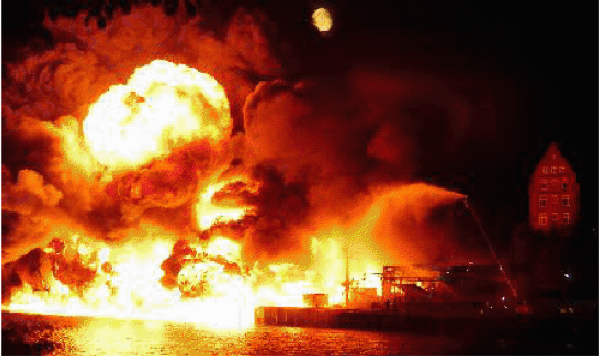
Until August 1945, when atomic bombs were dropped on Hiroshima and Nagasaki, story she knew only two explosives of comparable power, each of which cost the lives of thousands of people and caused enormous material damage. One of them occurred in 1944 in the Indian Bombay during the explosion of the Fort Steikin. Even a few decades later, when it comes to the past, in Bombay they use the expressions "when the ship exploded," "before the explosion," or "after the explosion." For the residents of this city 14 April 1944 of the year - the date from which the new countdown began. However, the world community about this explosion has long been known relatively little, since it happened in wartime, and the information was classified.
On a cold misty morning on 24 in February, 1944 from England to India left a convoy of twenty ships, including Fort Staikin. His captain, an experienced sailor, Alexander D. Naismith, on the one hand, did not feel any particular alarm, because he knew that the newly built ship was reliable, and the weather was normal for the Atlantic. Naismith, on the other hand, was disturbed by the load - extremely dangerous and at the same time responsible. What just was not on the deck and in the five holds of Fort Staikin! Disassembled fighter aircraft "Spitfire", explosives, ammunition and most importantly - gold: bars worth about a million pounds, which were intended for the Bombay Bank.
In the Atlantic convoy increased and began to number fifty transports, accompanied by two aircraft carriers, and at the very Gibraltar, it was divided in two. Most of the ships turned to West Africa, and the rest joined the new convoy, which came from the United States, and headed to the Mediterranean Sea. The Fort Staikin was with them.
One evening, when the Fort Staikin was on the traverse of Algeria, the alarm bells suddenly sounded. Four German bomber at a low altitude swept over the ships. Chipped anti-aircraft guns. When the order came to put a smoke screen, it turned out that the smoke buoys were useless: one of them lit a bright flame, and the sailors with great difficulty managed to eliminate the fire. This time everything went well. The air attack was repulsed.
Air alarms were announced more than once, but Fort Staikin was lucky. Having reached Aden, the ship replenished its reserves and, already alone, headed for Karachi. The Arabian Sea passed without incident, and Fort Staikin 30 March arrived at the port of destination. After partial unloading, Naismith was persuaded to take on additional cargo for Bombay - raw cotton in piles, barrels with machine oil, wood, scrap metal, mineral fertilizers, sulfur, pitch and cereals. Captain Naismith certainly knew that since it was military time, every ship was obliged to take full cargo. He also knew that cotton is a dangerous cargo, capable of self-igniting under certain conditions, especially when it comes into contact with oil and oils. But there was nothing to do. Before leaving, he told his assistants: “Almost all of our cargo is either flammable or explosive, but the only thing we can do is conduct additional fire drills.”
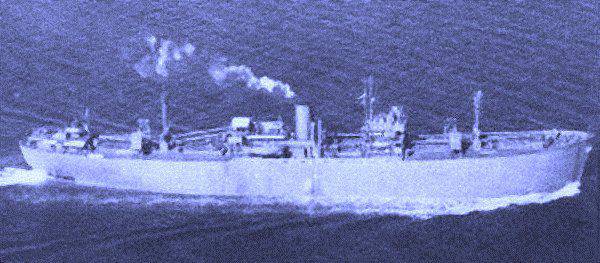
After leaving Karachi, Fort Staikin joined the convoy of tankers from the Persian Gulf. The three-day crossing was completed safely, but the crew was constantly harassed by dangerous cargo.
On April 12, the ship arrived on the Bombay raid and a few hours later it landed at berth No.1 of the Victoria dock. Nobody knew what cargo was in the holds of the arriving steamer, although according to the rules a vessel with dangerous cargo on board was obliged to raise a red flag. But ships carrying ammunition were especially often targeted by enemy aircraft, and by 1944, the captains became more cautious, so the rule was almost always broken.
When the representatives of the port authorities arrived at Fort Staikin, Captain Naismith immediately introduced them to the composition and placement of the cargo. However, the message about the presence on board of explosives made no particular impression on them. Slow unloading began only the next morning - April 13. A little more than a day remained before the disaster. April 14 unloading continued. Then the bill went already for hours, and then - for minutes.
In 12 hours 30 minutes, the crew commander of the ship “Fort Crevier”, standing in the same dock, notices a light smoke flowing from the deflector of the hold No. 2 “Fort Staikin”. An hour later, from his post, which was near the entrance to the dock, he saw the smoke and the assistant inspector of Bombay police. He did not assume that there could be a fire on one of the ships.
In 13 hours 45 minutes loaders, working on the Fort Staykine, notice in the hold smoke, rising on the port side. An alarm is raised on the ship and the fire is extinguished by water. The fire brigade on duty was connected to the fire. The Bombay fire brigade sent eight more fire engines to the ship.
By 15 hours, the Bombay Fire Department Chief arrives on the ship; the officer responsible for the explosives in the docks; General manager of the docks and deputy head of the security docks. By this time, the fire is extinguished already from 32 hoses.
We can say that Fort Fortress once again confirmed the correctness of the saying “Seven nannies have a child without an eye”. In fact: on the quay, as we see, a lot of different chiefs gathered, each of whom assessed the situation in his own way and gave his own advice. The explosives specialist believed that the situation was very dangerous and the only possible way to save the docks was to sink the ship. However, this was impossible to perform because of the shallow depth, and Captain Naismith, of course, was against it. Someone offered to batten down the hatch and fill the hold with steam, but this method had to be abandoned, as it was impossible to get to the hatch of the lower hold. The general manager of the docks believed that the vessel should be brought to an external raid. However, it could not go on its way - the car was being repaired, and it was too late to take it out with the help of tugs, since in this case it would have been necessary to disconnect all the arms of the fire engines, which sharply increased the danger of an explosion. According to another specialist, the only way out was to quickly bring water vessels to the burning vessel and thus increase the volume of water poured into the hold. The Soviets gave everything, but everyone thought they had no right to take command and give orders to others. And the fire inflamed. Further events developed as follows.
In the 15 hours of 10 minutes, paint began to bubble up on a small portion of the beadboard from the heat, and an attempt was made to cut the side of the fire, but the gas-cutting unit was faulty. By half past three in the hold №2 900 t of water was already poured. By this time, the top stacks of cotton bales are already burning.
By the 15 watch, 45 minutes were lit up with boxes of explosives. The fire subsides, then flares up even more. Five minutes later, from the hold number 2 to the height of the mast burst a tongue of flame. Firefighters and the crew flee the ship. The warehouse building on the pier caught fire.
Exactly on the 16 clock, the first explosion struck at Fort Staykin. Torn off by the explosion of the bow of the vessel sank. The fire spread to the hold number 4 with explosives. Forty minutes later, the second explosion thundered on Fort Fortin.
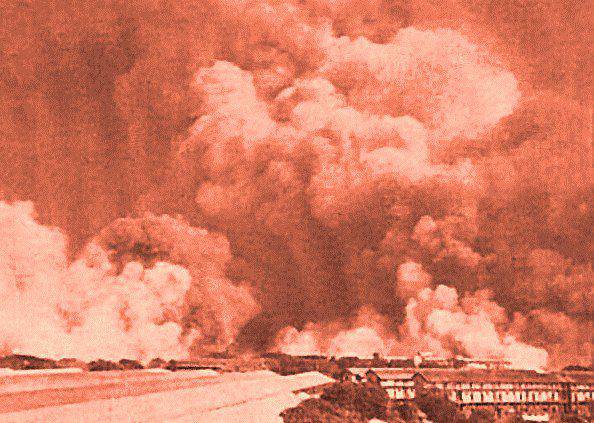
The few surviving eyewitnesses to the first explosion, who knew its causes, believed that Fort Staikin had exploded completely, and the only thing that had to be done was to save the wounded and abandon all forces to fight the fire at the docks. However, the situation was different. The first explosion was cut by the stern bulkhead of the second hold, the bow of the vessel, which, having flown ten meters ahead, sank. The stern part remained afloat and continued to burn. And in the hold number 4 explosives were two times more than in the hold number 2. Therefore, the second explosion was much more destructive than the first one. It occurred deep in the hold; the height of the column of fire and smoke reached a kilometer. A huge mass of metal, wood, incendiary bombs, burning cotton bales and oil barrels spread more than 2 km from the epicenter of the explosion.
Stored warehouses and warehouses. Lighters falling from the sky were torn. It's a black day for Bombay. Chaos in the aftermath of the disaster was no less than the one that reigned on Fort Staykine before the explosion. People who understood the need for leadership and took it upon themselves could not, due to the lack of a plan developed in advance for such a case, fully capture the situation and coordinate the actions of thousands of volunteers. Later, commenting on this, one Indian magazine wrote: “The symbol of how Bombay met this terrible catastrophe is a lonely man with a fire barrel in his hands, and this man does not really know what to do.”
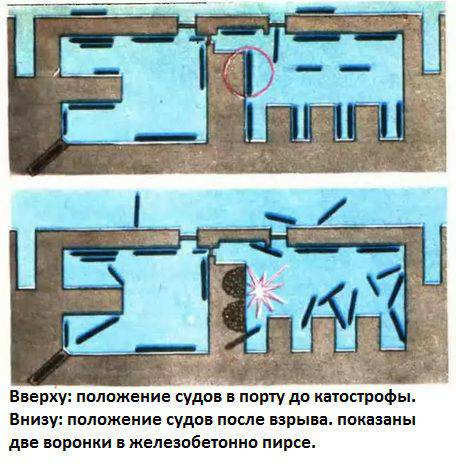
Around the place where Fort Steikin stood, raging fire formed a hellish ring with a radius of about 900 m. The fire spread almost a mile along the railroad tracks between the warehouses and the residential part of the city and broke into the streets where crowded houses of local residents. Local ships sailing at sea fleet posed a mortal threat to the rest of the vessels that were on the outer roadstead.
A gross miscalculation in the organization of fire fighting was that the docks "Prince" and "Victoria", which became the center of a general fire, were left to fend for themselves. Without this, many valuable ships could be saved. This happened partly because many knowledgeable and experienced people died as a result of explosions.
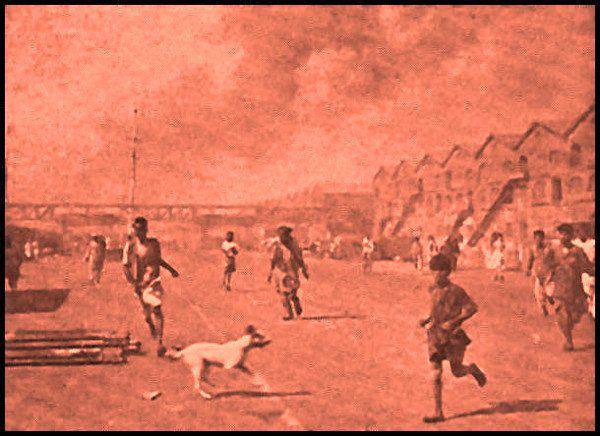
A common misfortune rallied people stronger than any orders. All people - military and civilians, the British and Indians, worked tirelessly and fiercely. Volunteers manually dragged over 2000 tons of ammunition stored there from the neighboring dock “Alexander”. They fought with fire, saved people, pulled valuable goods from warehouses to a safe place. The difficult task faced the Bombay hospitals. The victims began to arrive within minutes after the first explosion. Volunteers came and offered their help. And although some of them could only serve tea, for the wounded it meant more than just a favor: a sip of water in a sultry April can save lives. Many pharmacists gave medicine for free.
The consequences of a catastrophe can only be called terrible. It was destroyed almost square mile of urban development, the most "saturated" values. Hundreds of people died and were injured, thousands lost their homes and jobs. In official reports, the government tried to conceal the severity of the disaster, of course, that among the inhabitants of the country went the most incredible rumors about the causes of the fire, and about its consequences. However, the reality was worse than the most fantastic speculation. According to some experts, the loss was estimated at 20 million pounds, but in reality it was impossible to evaluate it in money. The vessels with a total capacity of about 35 thousand tons died. The disaster affected 6000 companies and left thousands of people without work 50. Almost 3 thousands of people lost everything they had. The fire consumed 55000 tons of grain destined for the population, and this is in a country devastated by long crop failures.
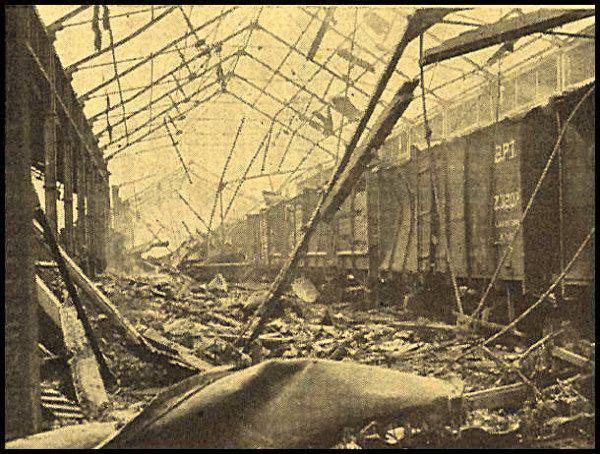
No one will ever know how many people died in the bombing bombings. The officially announced figure - 500 man - is very understated. Comparing the various data experts, believe that these days in Bombay killed about 1400 and injured about 2500 people.
All these terrible consequences had, in essence, one root cause: the presence on one ship and even in one hold of such absolutely incompatible goods as cotton and lube, and as a result - spontaneous combustion of the cargo.
Had the Bombay disaster in peacetime, the elimination of its consequences would take more than one year. But this time, the organization of work was on top. The initiative and perseverance of many people helped to overcome very serious difficulties: after seven months, the docks re-entered service.
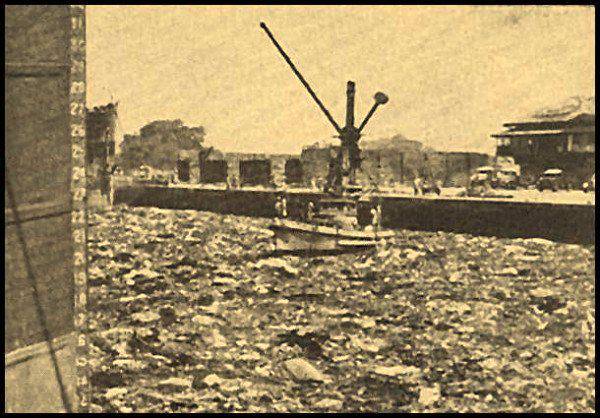
Sources:
Innis J. Bombay Blast. L .: Shipbuilding, 1989, C.6-7, 41-60.
Muromov I.A. 100 great shipwrecks. M: Veche, 2003. C. 247-255.
Scriagin L. Secrets of marine disasters. M .: Transportation, 1986. C. 149-152.
Glebov I. Bombay tragedy // Boats and yachts. 1985. No.8. C. 101-103.
Scriagin L. Smerch over the pier. Technology - youth. 1977. No.7. C. 54-57.
Information